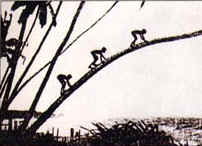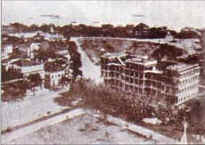
Curious scenes from a film.
c. 1897-98

James Watson's Hotel
THE
ARRIVAL OF CINEMA - 1896-1912
Though cinema came to India in 1896 it was not till as late as 1917 that the new medium
acquired the semblance of a business. During the intervening decades it was considered to
be a little more than "a playground miracle" which would probably last as long
as it took to invent another such spectacle. The fact that its inventor Louis Lumiere sold
out his rights, after a few years of commercial exploitation, to Charles Pathe in 1900,
bears ample testimony to the scant faith he had in its longevity as a medium of
entertainment. How wrong Lumiere was in the assessment of his own invention is borne out
by the rapidity with which "moving pictures" caught on not only in the United
States but all over the world.
The Lumiere envoy responsible for bringing the films to India was Maurice Sestier who had actually halted here on his way to Australia. Maurice Sestier was one among a brigade of trained cameramen, who had been sent all over the world with the Lumiere product. They were capable of shooting films as well as projecting them. Though Sestier brought the motion picture to India he failed in his mission in at least one respect: the films that he had exposed in India and sent back to Paris had been pronounced "incompetent" by his bosses. This probably explains why no Indian films were listed in the early Lumiere catalogues which had more than 1200 films from literally every part of the world.
It was not that the Indian public had never seen a moving
picture show. As in Europe and America, magic lantern shows were also popular in India
much before the advent of cinema. Many of the more enterprising showmen like Madanrao
Mahadev Pitale even used several consecutively placed slides to tell a story. Inspired to
go beyond Pitale's experiments in narration, Mahadeo Gopal Patwardhan procured an old
magic lantern and began to experiment with the art of making slides in 1890.
Some early exhibitors like Abdoolally Esoofally and Jamshedji Framji Madan went on to
create exhibition empires and were virtual witnesses to the march of cinema in India.
Along with exhibition, the production of films also received a boost. The visiting showmen
were not blind to the scenic potential that India offered. As they toured the country
exhibiting their repertoire they began to photograph the exotica of colonial India and the
first "Indian" films began to make an appearance: Coconut Fair, Our Indian
Empire (both 1897), The Flower Of Persia, A Panorama Of Indian Scenes (both 1898), Train
Arriving At Bombay Station, Poona Races '98 (both 1899). However, the first truly Indian
film was made by Harishchandra Sakharam Bhatawdekar, also known as Sawe Dada, a still
photographer and equipment dealer who had his studio at the Kennedy Bridge in Bombay.
The shows were held in makeshift tents, small halls of institutes like the Framji Cawasji
Institute at Dhobi Talao in Bombay and hastily converted drama theatres like the Novelty
or the Gaiety (now known as the Capitol). The more elite of these shows were held at the
Watson's Hotel and sometimes even the Town Hall. Thus began what was later to become a
flourishing exhibition trade. Slowly Indians began to be attracted to the trade which had
created markets as far-flung as Sumatra and Java. In fact, many of the early Indian
filmmakers actually began as exhibitors of imported shorts.
Home
The Trio
Sawe Dada
The Patwardhans